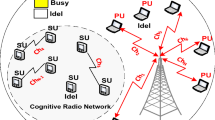Abstract
This work is directed towards a symbiotic architecture called cognitive relaying with frequency incentive for multiple primary users (CRFI-M). The rationale of CRFI-M is that the primary users (PUs) of a cognitive radio (CR) network, with weak transmission links, seek cooperation from the secondary user (SU) nodes in their vicinity to achieve as much throughput as they can get from their direct links. In return they reward the SUs with incentive frequency bands for their own communication. Each PU has its own distinct bandwidth of operation; however, when relaying through the SU network it can also use the bandwidth of the other PUs to enhance its throughput. Furthermore, the incentive frequency bands may be offered as a complete band-set or interleaved bands. Cross-layer optimization problems are formulated for each of these variants of the CRFI-M paradigm in a multi-hop multi-channel SU network. The frequency incentive that should be awarded to the SUs by each PU is analyzed by means of a utility-based decision-making process, and its efficient utilization is proposed. To make the CRFI-M scheme practically realizable, a MAC scheduling protocol is described. Simulation results are furnished to demonstrate the proof of concept.









Similar content being viewed by others
References
Haykin, S. (2005). Cognitive radio: Brain-empowered wireless communications. IEEE Journal on Selected Areas in Communications, 23, 201–220.
Akyildiz, I. F., Leea, Won-Yeol, Vuran, M. C., & Mohantya, S. (2006). NeXt generation/dynamic spectrum access/cognitive radio wireless networks: A survey. Computer Networks, 50(13), 2127–2159.
Simeone, O., Bar-Ness, Y., & Spagnolini, U. (2009). Cooperative cognitive radio. In Y. Zhang, H-H. Chen & M. Guizani (Eds.); Cooperative wireless communications, pp. 209–230. Auerbach Publications, CRC Press.
Simeone, O., Stanojev, I., Savazzi, S., Bar-Ness, Y., Spagnolini, U., & Pickholtz, R. (2008). Spectrum leasing to cooperating secondary adhoc networks. IEEE Journal on Selected Areas in Communications, 26(1), 203–213.
Zhang, J., & Zhang, Q. (2009). Stackelberg game for utility-based cooperative cognitive radio networks. In Proceedings of ACM MobiHoc, pp. 23–32.
Xue, P., Gong, P., Cao, N., & Kim, D. K. (2009). Symbiotic Architecture for the cognitive radio networks with amplify-and-forward relaying cooperation. In Proceedings of KICS the 18th JCCI, Jeju, Korea, pp. 49–54.
Gong, P., Park, J. H., Yoo, J. M., Yu Bo-Sun, & Kim, D. K. (2009). Throughput maximization with multiuser non-selfish cognitive relaying in CR networks. In Proceedings of 4th international symposium on wireless, pervasive computing, pp. 1–5.
Nadkar, T., Thumar, V. M., Desai, U. B., & Merchant, S. N. (2011). Symbiotic cooperative relaying in cognitive radio networks with time and frequency incentive. Springer Telecommunications System Journal: Special Issue on Mobile Computing and Networking Technologies. doi:10.1007/s11235-011-9494-4.
Nadkar, T., Thumar, V. M., Shenoy, G., Mehta, A., Desai, U. B., & Merchant, S. N. (2011). A crosslayer framework for symbiotic relaying in cognitive radio networks. In Proceedings of IEEE symposium on new frontiers in dynamic spectrum access networks (DySPAN ’11), pp. 498–509.
Nadkar, T., Thumar, V. M., Shenoy, G., Desai, U. B., & Merchant, S. N. (2011). Cognitive relaying with frequency incentive. In Proceedings of the IEEE global telecommunications conference (GLOBECOM ’11), Accepted.
Nadkar, T., Thumar, V. M., Shenoy, G., Desai, U. B., & Merchant, S. N. (2011). Cognitive relaying with time incentive: Protocol design for multiple primary users. In Proceedings of IEEE symposium on personal, indoor and mobile radio communications (PIMRC 11), Accepted.
Thumar, V. M., Nadkar, T., Shenoy, G., Desai, U. B., & Merchant, S. N. (2011). Cognitive relaying with time incentive: Multiple primary users. In Proceedings of IEEE vehicular technology conference (VTC 11), pp. 1–5.
Shi, Y., Hou, Y., & Kompella, S. (2008). A cross-layer approach to multi-hop networking with cognitive radios. In Proceedings of IEEE MILCOM08, pp. 1–7.
Bertsekas, D. P. (1998). Network optimization—continuous and discrete models. Belmont: Athena Scientific.
Zhang, J., Zhang, Z., Luo, H., & Huang, A. (2008). A column generation approach for spectrum allocation in cognitive wireless mesh network. In Proceedings of the IEEE global telecommunications conference. IEEE GLOBECOM, pp. 1–5.
Deuflhard, P. (2004). Newton methods for nonlinear problems. Affine invariance and adaptive algorithms. Springer Series in Computational Mathematics, vol. 35, Springer.
Thumar, V. M., Nadkar, T., Desai, U. B., & Merchant, S. N. (2011). Utility-based decision-making for symbiotic cooperative relaying in cognitive radio networks. In Proceedings of european wireless conference (EW’11), pp. 1–7.
LINDO Systems Inc. (2006). LINGO: User’s guide.
Acknowledgments
This work has been supported in part by the Ministry of Communication and Information Technology, Govt. of India. The work has also been supported by the Microsoft Research India PhD Fellowship Award 2009.
Author information
Authors and Affiliations
Corresponding author
Appendix
Appendix
The variable \(u_{m}(q)\) defined in BRR-BSM (problem P1) indicates the occupancy of band \(m \in \mathbb M _q\) in the entire network for any session \(q\). It is as given by
We would prefer to write it using arithmetic operations, as they are easier to work with. We use the following lemma:
Lemma For binary variables (0 or 1), multiplication and logical AND operations are identical.
Therefore, we can write,
When we take the sum of all \(u_m(q)\), and seek to minimize it, we are in effect minimizing the cumulative band-set used by all the sessions.
The same can be said about \(u_m\) defined in ABR-BSM (problem P3).
Rights and permissions
About this article
Cite this article
Nadkar, T., Thumar, V., Merchant, S.N. et al. Cognitive Relaying with Frequency Incentive for Multiple Primary Users. Wireless Pers Commun 74, 167–187 (2014). https://doi.org/10.1007/s11277-012-0952-4
Published:
Issue Date:
DOI: https://doi.org/10.1007/s11277-012-0952-4




